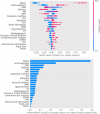Machine learning-based diagnostic model for stroke in non-neurological intensive care unit patients with acute neurological manifestations
- PMID: 39609571
- PMCID: PMC11605086
- DOI: 10.1038/s41598-024-80792-6
Machine learning-based diagnostic model for stroke in non-neurological intensive care unit patients with acute neurological manifestations
Abstract
Stroke is a neurological complication that can occur in patients admitted to the intensive care unit (ICU) for non-neurological conditions, leading to increased mortality and prolonged hospital stays. The incidence of stroke in ICU settings is notably higher compared to the general population, and delays in diagnosis can lead to irreversible neurological damage. Early diagnosis of stroke is critical to protect brain tissue and treat neurological defects. Therefore, we developed a machine learning model to diagnose stroke in patients with acute neurological manifestations in the ICU. We retrospectively collected data on patients' underlying diseases, blood coagulation tests, procedures, and medications before neurological symptom onset from 206 patients at the Chungbuk National University Hospital ICU (July 2020-July 2022) and 45 patients at Chungnam National University Hospital between (July 2020-March 2023). Using the Categorical Boosting (CatBoost) algorithm with Bayesian optimization for hyperparameter selection and k-fold cross-validation to mitigate overfitting, we analyzed model-feature relationships with SHapley Additive exPlanations (SHAP) values. Internal model validation yielded an average accuracy of 0.7560, sensitivity of 0.8959, specificity of 0.7000, and area under the receiver operating characteristic curve (AUROC) of 0.8201. External validation yielded an accuracy of 0.7778, sensitivity of 0.7500, specificity of 0.7931, and an AUROC of 0.7328. These results demonstrated the model's effectiveness in diagnosing stroke in non-neurological ICU patients with acute neurological manifestations using their electronic health records, making it valuable for the early detection of stroke in ICU patients.
Keywords: Clinical decision support system; Intensive care unit; Neurological manifestation; Stroke.
© 2024. The Author(s).
Conflict of interest statement
Declarations. Competing interests: The authors declare no competing interests. Ethical approval and study design: This study was approved by the Institutional Review Boards (IRBs) of Chungbuk National University Hospital (CBNUH) and Chungnam National University Hospital (CNUH) (IRB No: 2021-02-034-001). In addition, all methods used in this study were carried out under the IRBs of CBNUH and CNUH guidelines and regulations. We utilized a comprehensive hospitalization dataset of patients from CBNUH between July 2020–July 2022. Informed consent: The need for written informed consent was waived owing to the retrospective nature of the study.
Figures






Similar articles
-
Development and validation of an interpretable machine learning model for predicting in-hospital mortality for ischemic stroke patients in ICU.Int J Med Inform. 2025 Jun;198:105874. doi: 10.1016/j.ijmedinf.2025.105874. Epub 2025 Mar 9. Int J Med Inform. 2025. PMID: 40073651
-
Twenty-eight-day in-hospital mortality prediction for elderly patients with ischemic stroke in the intensive care unit: Interpretable machine learning models.Front Public Health. 2023 Jan 12;10:1086339. doi: 10.3389/fpubh.2022.1086339. eCollection 2022. Front Public Health. 2023. PMID: 36711330 Free PMC article. Clinical Trial.
-
Illness severity assessment of older adults in critical illness using machine learning (ELDER-ICU): an international multicentre study with subgroup bias evaluation.Lancet Digit Health. 2023 Oct;5(10):e657-e667. doi: 10.1016/S2589-7500(23)00128-0. Epub 2023 Aug 18. Lancet Digit Health. 2023. PMID: 37599147
-
Dynamic and explainable machine learning prediction of mortality in patients in the intensive care unit: a retrospective study of high-frequency data in electronic patient records.Lancet Digit Health. 2020 Apr;2(4):e179-e191. doi: 10.1016/S2589-7500(20)30018-2. Epub 2020 Mar 12. Lancet Digit Health. 2020. PMID: 33328078
-
External validation of AI-based scoring systems in the ICU: a systematic review and meta-analysis.BMC Med Inform Decis Mak. 2025 Jan 6;25(1):5. doi: 10.1186/s12911-024-02830-7. BMC Med Inform Decis Mak. 2025. PMID: 39762808 Free PMC article.
References
-
- Ortega-Gutierrez, S. et al. Neurologic complications in non-neurological intensive care units. Neurologist15, 254–267 (2009). - PubMed
-
- Bleck, T. P. et al. Neurologic complications of critical medical illnesses. Crit. Care Med.21, 98–103 (1993). - PubMed
-
- Davies, N. W., Sharief, M. K. & Howard, R. S. Infection–associated encephalopathies—their investigation, diagnosis, and treatment. J. Neurol.253, 833–845 (2006). - PubMed
MeSH terms
Grants and funding
LinkOut - more resources
Full Text Sources
Medical

